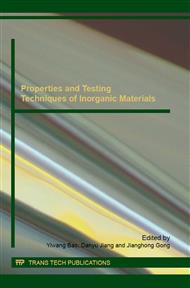p.244
p.248
p.252
p.257
p.261
p.267
p.272
p.278
p.285
The Solution Dependence of Cu Modification During the Synthesis of γ-Fe2O3 Nanoparticles
Abstract:
During the synthesis of γ-Fe2O3 nanoparticles by a chemically-induced transition method in FeCl2 solution, Cu modification was attempted by adding CuCl/NaOH or CuCl2/NaOH to the solution. The as-prepared products were characterized using VSM, TEM, EDS, XRD, and XPS. When adding a NaOH solution with a certain concentration, the components of the as-prepared products changed in relation to the copper salt used. When CuCl 2.5 × 10-3 M was used, γ-Fe2O3/CuFeO2 composite nanoparticles coated by FeCl3·6H2O and with an average size of 11.47 nm were formed. When the CuCl concentration increased to 5 × 10-2 M, a mixture of γ-Fe2O3/CuFeO2 and Cu (OH)Cl nanoparticles was formed. When 5 × 10-2 M CuCl2 was used, the final product contained γ-Fe2O3 nanoparticles, coated with FeCl3·6H2O, and Cu (OH)Cl nanoparticles. The magnetization of the as-prepared products depends on the content of the γ-Fe2O3 and CuFeO2 ferrites.
Info:
Periodical:
Pages:
261-266
Citation:
Online since:
February 2016
Authors:
Keywords:
Price:
Сopyright:
© 2016 Trans Tech Publications Ltd. All Rights Reserved
Share:
Citation:


